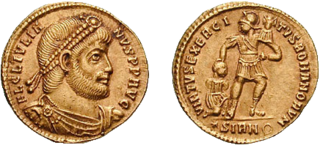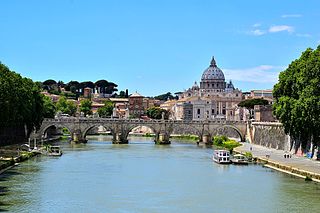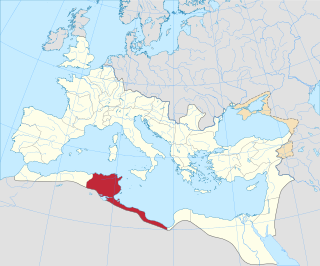Sextus Julius Major was a Roman senator active during the first half of the second century, and who held several positions in the service of the emperor. Major was suffect consul around 126. Major's origins were with the "high aristocracy" of Asia Minor. Ronald Syme notes his ancestors included Polemon I the king of Pontus and Antonia Pythodoris.
Lucius Minicius Rufus was a Roman senator. He was best known as an acquaintance of the philosopher and wonder-worker Apollonius of Tyana.
Lucius Catilius Severus Julianus Claudius Reginus was a Roman senator and general active during the reigns of Trajan and Hadrian. He was appointed consul twice: the first time in 110 CE with Gaius Erucianus Silo as his colleague; the second in the year 120 with the future emperor Antoninus Pius as his colleague. Catilius was also the step-great-grandfather of the emperor Marcus Aurelius.
The gens Minicia was a plebeian family at Rome. Members of this gens are first mentioned in the first century, achieving the consulate under the emperor Claudius. Owing to the similarity of their names, the Minicii are regularly confused with members of the ancient and far more prominent gens Minucia.
Lucius Julius Marinus Caecilius Simplex was a Roman senator who held several posts in the emperor's service. Simplex was then appointed suffect consul in late 101, with Lucius Arruntius Stella as his colleague. His career is primarily known through inscriptions.
Marcus Paccius Silvanus Quintus Coredius Gallus Gargilius Antiquus was a Roman senator of the 2nd century AD. He was suffect consul in the nundinium of May-June 119 as the colleague of Quintus Vibius Gallus. Gargilius Antiquus is primarily known through inscriptions.
Aulus Caecilius Faustinus was a Roman senator active during the reign of Trajan. He was suffect consul for the nundinium starting in August AD 99 as the colleague of Quintus Fabius Barbarus Valerius Magnus Julianus. Faustinus is known primarily from inscriptions.
Quintus Pomponius Rufus was a Roman senator active in the imperial service; he was governor during the reigns of the emperors Domitian and Trajan. Rufus was also suffect consul for the nundinium September-December AD 95 as the colleague of Lucius Baebius Tullus. Pomponius Rufus is known primarily from inscriptions.
Publius Nonius Asprenas Caesius Cassianus was a Roman senator who was active in the first century. He was appointed suffect consul by Vespasian in either 72 or 73. Cassianus is known only through inscriptions. He is the son of Publius Nonius Asprenas Calpurnius Serranus, ordinary consul of 38.
Lucius Valerius Propinquus was a Roman senator active in the second century AD. He was suffect consul who replaced the ordinary consul Marcus Annius Verus and was the colleague of the other ordinary consul, Gaius Eggius Ambibulus, for the remainder of the first nundinium of 126.
Publius Afranius Flavianus was a Roman senator who held at least one office in the service of the emperor. It is believed Flavianus was suffect consul in one of the nundinia that fell in the last half of 117, based on a restoration of a military diploma dated 18 August; if this restoration is correct, then he was the colleague of Lucius Cossonius Gallus. Flavianus is known only through surviving inscriptions.
Lucius Vitrasius Flamininus was a Roman senator of the second century. He was suffect consul during 122 as the colleague of Tiberius Julius Candidus Capito. Flamininus is primarily known from inscriptions.
Marcus Pompeius Macrinus Neos Theophanes was a Roman senator of the second century who held several imperial appointments. He was suffect consul during the nundinium of September-December 115 with Titus Vibius Varus as his colleague. Older writers like Ronald Syme had dated his career some fifteen years earlier, but subsequent research confirmed a later date. Macrinus is primarily known from inscriptions.
Lucius Luscius Ocrea was Roman senator of the first century. He was suffect consul in either the years 77 or 78. Ocrea is primarily known from inscriptions.
Gaius Calpurnius Flaccus was a Roman senator of the second century. He was attested suffect consul with Lucius Trebius Germanus as his colleague on 15 December of an undetermined year between 122 and 127. Both Flaccus and Germanus are primarily known from inscriptions.
Lucius Hedius Rufus Lollianus Avitus was a Roman senator active in the first quarter of the second century AD. He was suffect consul for the nundinium September-December AD 114 with Marcus Messius Rusticus as his colleague. Many of the inscriptions referring to Avitus used the shorter form of his name, Lucius Lollianus Avitus. He is primarily known through inscriptions.
Lucius Cornelius Pusio Annius Messala was a Roman senator who replaced the emperor Domitian as suffect consul from 13 January 90 to the end of February. He is also known by the shorter form of his name, Lucius Cornelius Pusio.
Sextus Octavius Fronto was a Roman senator and a military figure, who held a number of offices in the emperor's service. He was suffect consul in the nundinium of May-August 86 with Tiberius Julius Candidus Marius Celsus as his colleague. Martial addressed one of his epigrams to Fronto, wherein he describes Fronto as "an ornament of military and civil life".
Lucius Attius Macro was a Roman senator and general, who was active during the early second century. He was suffect consul in the later part of AD 134 as the colleague of Publius Licinius Pansa. He is known entirely from inscriptions.
Lucius Aurelius Gallus was a Roman senator, who held a series of appointments during the first half of the second century AD. A military diploma found in Morocco attests that he was suffect consul on 18 August for one of the years between 129 and 132 as the colleague of ...cus Priscus. Gallus is known entirely from inscriptions.






